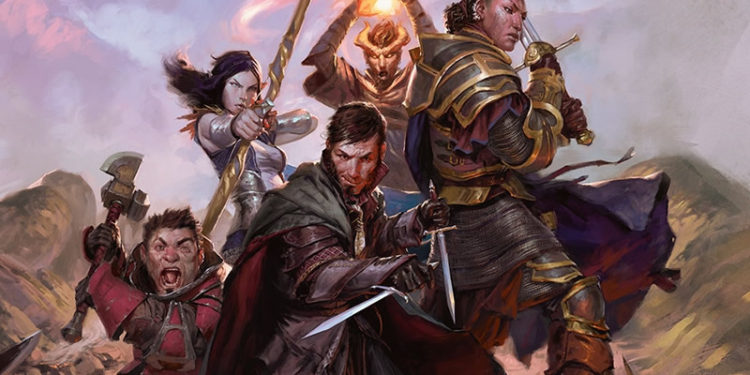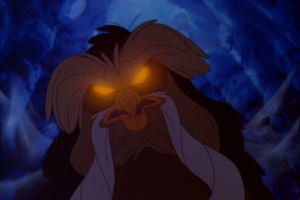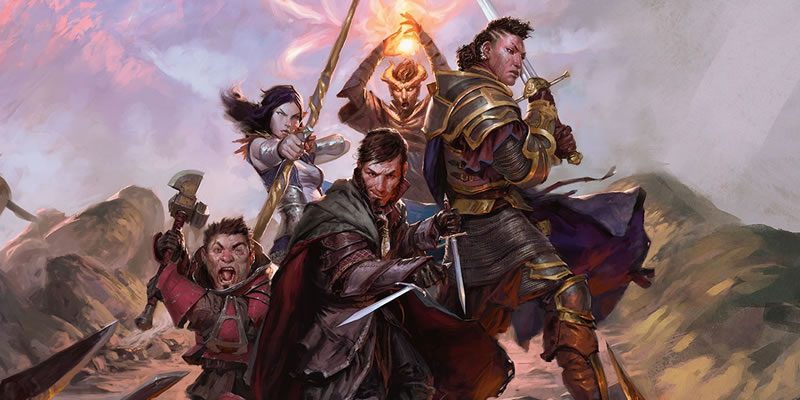Unearthed Arcana 2021: Folk of the Feywild Breakdown

There’s a new collection of Feywild (not all of them fey) races in the new Unearthed Arcana document, continuing the vein of new player races we last saw in Gothic Lineages. There are four new player races here, and every one of them came as a surprise to me in one way or other. I want to establish up front, though, that me making jokes about the fourth of those races won’t be a rare bit.
The byline for this one is Taymoor Rehman, Ari Levitch, and Jeremy Crawford, with input from the rest of the D&D design team.
Okay, it’s super easy to gloss over the intro text and miss the part where everyone gets +2 to one score, +1 to another, or +1 to three. I say this because I totally glossed over it, like the top-flight genius literate person that I am. Argh. I’m delighted not to have to choose between ability scores and cool features, because worrying about math-fixing is tedious as hell.
The Sidebar
As in Gothic Lineages, there’s some sidebar commentary on race design. Here, it’s an explicit statement that it is okay to play and playtest these races, the new racial mechanics of Tasha’s Cauldron of Everything, and races that predate Tasha’s.
Fairy
It’s possible that I’m forgetting it (not looking it up right now, or honestly even sure where I’d start), but I can’t think of when fairy has been a distinct thing in D&D, as separate from sprites and pixies and every other thing that Gygaxian taxonomy declares as an independent species. The Small size and Fey Characteristics table strongly suggests to me that it’s riffing on Honeythorn Gump and other fairies from Legend.
- Creature Type Fey. Immunity to effects that target humanoids, and… be careful about teaming up with Oath of the Ancients paladins.
- Size Small.
- 30-ft speed.
- Fairy Flight gives you a flying speed equal to your walking speed, the ability to hover, and no actual reliance on wings. I’m honestly surprised to see more PC races that fly from the start of play, but at least as a Small creature you probably don’t have an amazing carrying capacity to fly party members over chasms? I dunno. I’m still not wild about what always-on PC flight does to encounter design, especially emergent-play kinds of encounters.
- Fairy Magic teaches you druidcraft and faerie fire, and gives you one free casting of faeirie fire per long rest.
- Fey Passage is, surprisingly, not misty step. It’s just an ability to squeeze through spaces as little as 1 inch wide. Weird flex, but okay.
- Over on the bird site, Tomas (@TGimenezrGM) made the great point that being Small size with Fey Passage lets you describe your character as Tinkerbell-tiny, function as a rules object as if you are Small, but avoid all of the aggravating rules baggage that comes along with actually being Tiny. That’s a super smart idea, though I’m not sure if it’s the design team’s intent.
Highly mobile, a lot of minor miscellaneous effects, and some faerie fire? Yeah, that about tracks. I’d play this in a campaign that was going to lean hard on fey content, but probably not in any other kind of campaign.
Hobgoblins of the Feywild
I don’t recall any previous hint in D&D that goblins come from the Feywild, but, well, not looking it up. The goblins in my campaigns have always been pretty fey-inflected (see also my piece on goblin markets!), so I’m favorably disposed toward fey-affiliated hobgoblins.
- Creature type humanoid.
- Medium size.
- 30-ft walking speed.
- 60-ft darkvision.
- Fey Ancestry grants advantage on saves vs charm, as every schoolchild knows from elves.
- Fey Gift does a bunch of stuff. Stick with me.
- First, you can use the Help action as a bonus action, proficiency bonus times per long rest.
- At 3rd level, you tack on one of three bonus effects:
- Hospitality grants you and your target 1d6 + PB temporary hit points.
- Passage grants +10 ft speed to you and your target until the start of your next turn.
- Spite makes the next attack that you or your target hit with impose attack disadvantage on that creature’s next attack. (I’m not 100% clear if you both do this with your next attack, or whichever one of you hits first does this. Contextually, the former seems more likely.)
- There’s a lot going on here, but overall it’s communicating the Summer/Seelie, Gloaming/Unseelie, and general mobility themes of D&D fey. It also plays interestingly with the militaristic, cooperative non-fey hobgoblin story – everything here would still be very desirable for a hobgoblin soldier.
- Fortune from the Many lets you gain a bonus to an attack that has missed equal to the number of nearby allies, up to +5. It’s a rename and light retheme of Saving Face from the VGtM hobgoblin. I’m fine with seeing it again – it’s aesthetically pleasing to me that Feywild hobgoblins still have meaningful things in common with Prime hobgoblins.
I… could actually be clearer about whether this is a new hobgoblin variant or a replacement hobgoblin. The story hints at possibly being a full replacement, and I don’t object to that. In effect you’re trading proficiency in two martial weapons and proficiency in light armor for Fey Gift and Fey Ancestry, and… that’s a real trade up. It means your race is part of the story of your actions in the game more often, and that’s a big plus to me.
Also, the idea of a Seelie/Summer Court hobgoblin is super appealing right now.
Owlfolk
It’s not at all surprising that there should be a lot of anthropomorphic races in the Feywild. I haven’t perceived a ton of outcry for owl-people, but Don Bluth dismisses me as but a poor fool.

- Creature type humanoid.
- You can choose to be Medium or Small. Getting to choose your size reminds me that there are a ton of different owl aesthetics you could choose from – anything from the tiny elf owl to the massive Blakiston’s fish owl.
- 30-ft walking speed.
- 90-ft darkvision. Whatever I may say about darkvision, I concede that owlfolk without darkvision would be off-base.
- Magic Sight gives you detect magic as a ritual, plus the ability to cast it with any spell slots you have. Spending 10 minutes to bring up your magic sight feels a bit weird for a racial feature – one free standard casting per day + the ritual option would sell a lot of this story for me. Yes, I’m way in the weeds with this aesthetically.
- Nimble Flight gives you both a flying speed equal to your walking speed and a chance to catch yourself if you’re falling, with an easy Dex save. I would love to see that Dex save or one like it show up in monster stat blocks for wing-dependent flyers in the future, so that one knockdown isn’t a death sentence. The XGTE tweak to falling flyers is… okay, but it could use some tweaks for altitudes of 200+ feet.
- Doesn’t escape any of my concerns about 1st-level PC flight or the number and variety of exploration challenges this negates, of course.
- Silent Feathers grants proficiency in Stealth.
Overall… I don’t know for sure that this is a PC concept I would go for, but I don’t dislike it. As with fairies, in a Feywild-focused campaign, the whole look here moves way up in my priority list. Thinking of all the other animal races I’ve seen over the years, I’m honestly surprised there’s not a feature relating to their beak or talons. Not objecting – just surprised.
Rabbitfolk
The supporting fiction for humanoid rabbits is… let’s say it’s robust. How dare Mel Blanc be dead at a time like this? Richard Adams says, “Make them beasts and not humanoids, you cowards.” In the unlikely event you haven’t read the immortal Watership Down, it has some incredible lessons to teach about how to present action and challenge scenes, and… you know what, I’m in danger of haring off entirely into some kind of digression. (Okay but El-ahrairah is clearly an Archfey, and if someone doesn’t have fan art mashing up the Raven Queen and the Black Rabbit of Inlé, I don’t even know what we’re doing here.)
A couple more great rabbitfolk character options:
- Samurai fighter.
- Dhampir lineage.
- Noble (Knight) background. (Sorry, you can blame my friend Matt for this one.)
- Pretty soon we’ll be able to run the Hundred-Acre Wood as a West Marches campaign.
- Owlfolk
- Rabbitfolk
- Kobold Press has bearfolk
- Tabaxi (their heads are made out of rubber, their bottoms are made out of springs, it’s canon now)
- Get me some kangaroofolk and some donkeyfolk and some pigfolk and…
Right. I should get to the mechanics, huh?
“All the world will be your enemy, Prince with a Thousand Enemies, and whenever they catch you, they will kill you. But first they must catch you, digger, listener, runner, prince with the swift warning. Be cunning and full of tricks and your people shall never be destroyed.”
- Creature type humanoid.
- Size Medium or Small.
- 30-ft walking speed. Would have accepted a faster speed here. You’re supposed to be a runner.
- Hare-Trigger lets you add your proficiency bonus to initiative. Prince with the swift warning.
- Leporine Senses grants Perception proficiency. Listener.
- Lucky Footwork lets you add 1d4 to failed Dexterity saves, potential converting failure to success. I feel like I’m missing something about why it’s phrased like that, and not just “add 1d4 to your Dexterity saving throws.” Cunning and full of tricks.
- Rabbit Hop is an odd movement feature, in that when you move at least 5 feet on your turn, you can also hop 1d12 feet in any direction. Random rolls are not a great fit for grid-based play, but I do like rolls for vertical leaps. Obviously it’s no comparison to flight.
No real objections. Writing features that would also make you a digger sounds like a pain to balance. Owlfolk PCs, please do not make me tell you again that rabbitfolk PCs are friends, not food.
Conclusion
This is selling a Feywild quite different from what I expected, and y’all know that I have strong feelings about fey content. I don’t object to it, but I do think most D&D settings would have a constant “you’re a what now…?” reaction to three of the four races here. Each conversation starting with a few minutes on how unusual one aspect of one party member is would get old in a big hurry.
It’s fascinating to see the design team explore the mechanics that fit into their new goals and boundaries. If you’re a freelance 5e designer, I can’t emphasize this enough: you need to be thinking about how you’re going to design races going forward. Some publishers, I’m sure, won’t adopt WotC’s new style, but I suspect the broader community will make that position decreasingly tenable.



